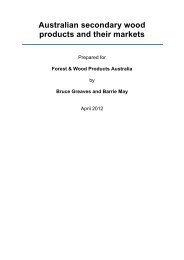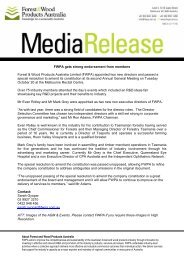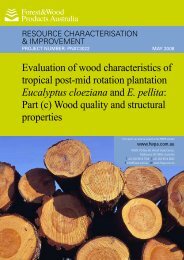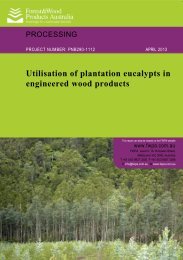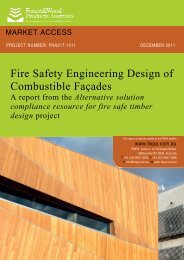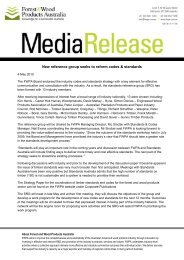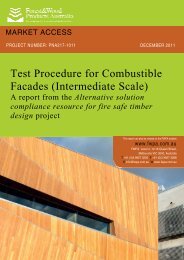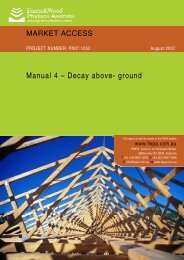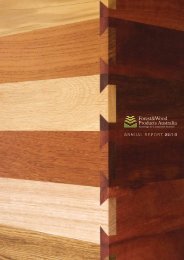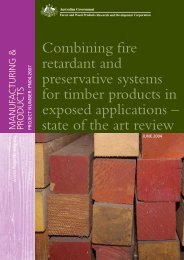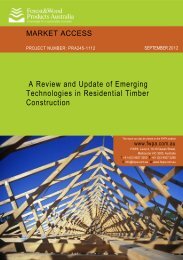guide to the specification, installation and use of preservative treated ...
guide to the specification, installation and use of preservative treated ...
guide to the specification, installation and use of preservative treated ...
You also want an ePaper? Increase the reach of your titles
YUMPU automatically turns print PDFs into web optimized ePapers that Google loves.
Page | 18<br />
GUIDE TO THE SPECIFICATION, INSTALLATION<br />
AND USE OF PRESERVATIVE TREATED<br />
ENGINEERED WOOD PRODUCTS<br />
Selection <strong>of</strong> <strong>the</strong> appropriate fastener material should be based on Table 5, depending upon<br />
<strong>the</strong> application <strong>and</strong> resulting hazards. Selection <strong>of</strong> <strong>the</strong> appropriate fastener will minimise <strong>the</strong><br />
potential corrosion <strong>of</strong> fasteners <strong>and</strong> breakdown <strong>of</strong> <strong>the</strong> wood around <strong>the</strong> fastener.<br />
The treatment type in <strong>the</strong> wood will influence <strong>the</strong> corrosion rate <strong>of</strong> <strong>the</strong> connec<strong>to</strong>r material<br />
according <strong>to</strong> Nordic <strong>and</strong> North American research. Generally research has shown that <strong>the</strong><br />
corrosivity <strong>of</strong> copper azole is similar <strong>to</strong> CCA (copper chromium arsenic) while <strong>the</strong> corrosivity<br />
<strong>of</strong> ACQ (ammoniacal copper quarternary) is approximately double that <strong>of</strong> CCA. As such, <strong>the</strong><br />
<strong>use</strong> <strong>of</strong> stainless steel in preference <strong>to</strong> hot-dip galvanised connec<strong>to</strong>rs is recommended in<br />
conjunction with ACQ <strong>treated</strong> wood where <strong>the</strong>re is a risk <strong>of</strong> elevated moisture content in <strong>the</strong><br />
wood.<br />
Connection design needs <strong>to</strong> accommodate or restrain any potential movement in <strong>the</strong> joint<br />
from moisture induced shrinkage <strong>and</strong> swelling <strong>of</strong> <strong>the</strong> EWPs.<br />
Minimise moisture traps <strong>and</strong> horizontal contact areas where moisture may enter.<br />
Connection capacity values for a range <strong>of</strong> st<strong>and</strong>ard fasteners are provided in AS1720.1 for<br />
solid timber, Glulam, plywood <strong>and</strong> LVL. Designers will need <strong>to</strong> refer <strong>to</strong> proprietary information<br />
on connection capacities <strong>of</strong> OSB <strong>and</strong> particleboard.<br />
More detailed guidance on connection durability design in timber is provided in <strong>the</strong> Timber Service<br />
Life Design (FWPA 2007).<br />
Selection <strong>guide</strong><br />
Table 6 provides a <strong>guide</strong> for designers for selection <strong>of</strong> appropriate Hazard Class <strong>and</strong> suitable EWPs<br />
for a wide range <strong>of</strong> typical applications. EWPs in exposed applications (H3 <strong>and</strong> higher hazards) must<br />
be protected by an appropriate combination <strong>of</strong> architectural detailing, surface finishing <strong>and</strong> a<br />
maintenance program. Regardless <strong>of</strong> <strong>preservative</strong> treatment, OSB <strong>and</strong> particleboard products are not<br />
currently recommended for long term exposure <strong>to</strong> H3 or higher hazards.<br />
Table 6: EWP selection chart<br />
Product application Sub-application Hazard<br />
class<br />
Suitable products<br />
Interior H1, H2 I-beams, Glulam, OSB, Plywood, LVL<br />
Beams<br />
Exterior H3 Glulam, Plywood, LVL<br />
Deck &superstructure H4 Plywood<br />
Boat building<br />
Hull H5, H6 Plywood<br />
Bus floors H3 Plywood<br />
Cladding<br />
H3 A<br />
H3<br />
Plywood, LVL<br />
LVL<br />
Compost bin H3, H4 Plywood, LVL<br />
Cooling <strong>to</strong>wer Structure H5 Plywood, LVL<br />
Bridge H3, H4, H5 Plywood, LVL<br />
Decking<br />
Wharf H3, H4, H5 Plywood, LVL<br />
Patio H3 Plywood<br />
Drain linings H5 Plywood<br />
Fascia board<br />
H3 A<br />
H3<br />
Plywood, LVL<br />
LVL<br />
Flooring<br />
Interior<br />
Exterior<br />
H1, H2<br />
H3<br />
Plywood, OSB, particleboard<br />
Plywood<br />
Interior H1, H2 I-beams, Plywood, OSB, particleboard,<br />
Glulam, LVL<br />
Framing<br />
Exterior<br />
H3<br />
H3 A<br />
Plywood, Glulam, LVL<br />
LVL<br />
Ho<strong>use</strong> – Wall – H2 I-beams, Plywood, OSB, particleboard,<br />
Subfloor<br />
Glulam, LVL



